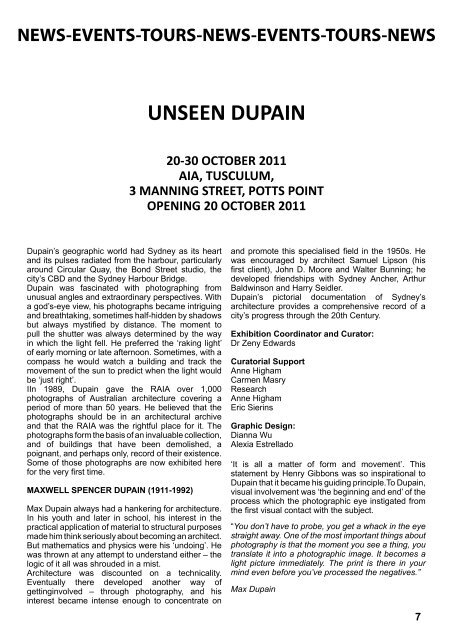The Eames House - Australian Architecture Association
The Eames House - Australian Architecture Association
The Eames House - Australian Architecture Association
Create successful ePaper yourself
Turn your PDF publications into a flip-book with our unique Google optimized e-Paper software.
NEWS-EVENTS-TOURS-NEWS-EVENTS-TOURS-NEWS<br />
UNSEEN DUPAIN<br />
20-30 OCTOBER 2011<br />
AIA, TUSCULUM,<br />
3 MANNING STREET, POTTS POINT<br />
OPENING 20 OCTOBER 2011<br />
Dupain’s geographic world had Sydney as its heart<br />
and its pulses radiated from the harbour, particularly<br />
around Circular Quay, the Bond Street studio, the<br />
city’s CBD and the Sydney Harbour Bridge.<br />
Dupain was fascinated with photographing from<br />
unusual angles and extraordinary perspectives. With<br />
a god’s-eye view, his photographs became intriguing<br />
and breathtaking, sometimes half-hidden by shadows<br />
but always mystified by distance. <strong>The</strong> moment to<br />
pull the shutter was always determined by the way<br />
in which the light fell. He preferred the ‘raking light’<br />
of early morning or late afternoon. Sometimes, with a<br />
compass he would watch a building and track the<br />
movement of the sun to predict when the light would<br />
be ‘just right’.<br />
IIn 1989, Dupain gave the RAIA over 1,000<br />
photographs of <strong>Australian</strong> architecture covering a<br />
period of more than 50 years. He believed that the<br />
photographs should be in an architectural archive<br />
and that the RAIA was the rightful place for it. <strong>The</strong><br />
photographs form the basis of an invaluable collection,<br />
and of buildings that have been demolished, a<br />
poignant, and perhaps only, record of their existence.<br />
Some of those photographs are now exhibited here<br />
for the very first time.<br />
MAXWELL SPENCER DUPAIN (1911-1992)<br />
Max Dupain always had a hankering for architecture.<br />
In his youth and later in school, his interest in the<br />
practical application of material to structural purposes<br />
made him think seriously about becoming an architect.<br />
But mathematics and physics were his ‘undoing’. He<br />
was thrown at any attempt to understand either – the<br />
logic of it all was shrouded in a mist.<br />
<strong>Architecture</strong> was discounted on a technicality.<br />
Eventually there developed another way of<br />
gettinginvolved – through photography, and his<br />
interest became intense enough to concentrate on<br />
and promote this specialised field in the 1950s. He<br />
was encouraged by architect Samuel Lipson (his<br />
first client), John D. Moore and Walter Bunning; he<br />
developed friendships with Sydney Ancher, Arthur<br />
Baldwinson and Harry Seidler.<br />
Dupain’s pictorial documentation of Sydney’s<br />
architecture provides a comprehensive record of a<br />
city’s progress through the 20th Century.<br />
Exhibition Coordinator and Curator:<br />
Dr Zeny Edwards<br />
Curatorial Support<br />
Anne Higham<br />
Carmen Masry<br />
Research<br />
Anne Higham<br />
Eric Sierins<br />
Graphic Design:<br />
Dianna Wu<br />
Alexia Estrellado<br />
‘It is all a matter of form and movement’. This<br />
statement by Henry Gibbons was so inspirational to<br />
Dupain that it became his guiding principle.To Dupain,<br />
visual involvement was ‘the beginning and end’ of the<br />
process which the photographic eye instigated from<br />
the first visual contact with the subject.<br />
“You don’t have to probe, you get a whack in the eye<br />
straight away. One of the most important things about<br />
photography is that the moment you see a thing, you<br />
translate it into a photographic image. It becomes a<br />
light picture immediately. <strong>The</strong> print is there in your<br />
mind even before you’ve processed the negatives.”<br />
Max Dupain<br />
7


